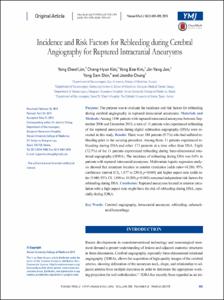KUMEL Repository
1. Journal Papers (연구논문)
1. School of Medicine (의과대학)
Dept. of Neurosurgery (신경외과학)
Incidence and Risk Factors for Rebleeding during Cerebral Angiography for Ruptured Intracranial Aneury
- Keimyung Author(s)
- Kim, Chang Hyun
- Department
- Dept. of Neurosurgery (신경외과학)
- Journal Title
- Yonsei Medical Journal
- Issued Date
- 2015
- Volume
- 56
- Issue
- 2
- Abstract
- Purpose: The purpose was to evaluate the incidence and risk factors for rebleeding during cerebral angiography in ruptured intracranial aneurysms. Materials and Methods: Among 1896 patients with ruptured intracranial aneurysms between September 2006 and December 2013, a total of 11 patients who experienced rebleeding of the ruptured aneurysms during digital subtraction angiography (DSA) were recruited in this study. Results: There were 184 patients (9.7%) who had suffered rebleeding prior to the securing procedure. Among them, 11 patients experienced rebleeding during DSA and other 173 patients at a time other than DSA. Eight (72.7%) of the 11 patients experienced rebleeding during three-dimensional rotational angiography (3DRA). The incidence of rebleeding during DSA was 0.6% in patients with ruptured intracranial aneurysms. Multivariate logistic regression analysis showed that aneurysm location in anterior circulation [odds ratio=14.286; 95% confidence interval (CI), 1.877 to 250.0; p=0.048] and higher aspect ratio (odds ratio=3.040; 95% CI, 1.896 to 10.309; p=0.041) remained independent risk factors for rebleeding during DSA. Conclusion: Ruptured aneurysms located in anterior circulation with a high aspect ratio might have the risk of rebleeding during DSA, especially during 3DRA.
Key Words: Cerebral angiography, intracranial aneurysm, rebleeding, subarachnoid hemorrhage
- Keimyung Author(s)(Kor)
- 김창현
- Publisher
- School of Medicine
- Citation
- Yong Cheol Lim et al. (2015). Incidence and Risk Factors for Rebleeding during Cerebral Angiography for Ruptured Intracranial Aneury. Yonsei Medical Journal, 56(2), 403–409. doi: 10.3349/ymj.2015.56.2.403
- Type
- Article
- ISSN
- 0513-5796
- Appears in Collections:
- 1. School of Medicine (의과대학) > Dept. of Neurosurgery (신경외과학)
- 파일 목록
-
-
Download
 oak-bbb-00029.pdf
기타 데이터 / 2.28 MB / Adobe PDF
oak-bbb-00029.pdf
기타 데이터 / 2.28 MB / Adobe PDF
-
Items in Repository are protected by copyright, with all rights reserved, unless otherwise indicated.